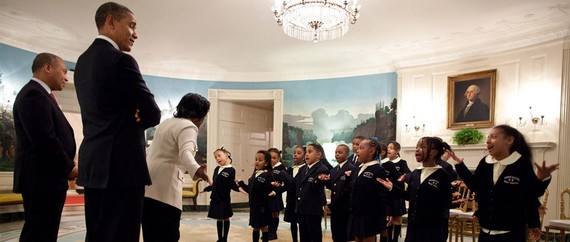First lady Michelle Obama, the President's Committee on the Arts and the Humanities (PCAH), the U.S. Department of Education, the National Association of Music Merchants (NAMM) and a number of top performers and artists met Monday at the White House to showcase the importance of arts and music education to student achievement.
At this event, Mrs. Obama talked about the success of the Turnaround Arts Initiative and announced that the program is now expanded to include 35 schools in Des Moines, Chicago, Boston, Minnesota, Louisiana, and California.
One of most aggressive efforts is being launched by Create California, a state effort to publish a blueprint for creative schools, headed by Malissa Feruzzi Shriver, former Chair of the California Arts Council, and Executive Director of Turnaround Arts CA, together with world-renowned architect Frank Gehry, and includes schools in the Kings, San Bernardino, Alameda, Los Angeles, Monterey, Humboldt, San Joaquin, Contra Costa and San Diego Counties.
Shriver and Gehry have recruited other well-known celebrities committed to be an artist mentor of a California school, such as Jason Mraz, Forest Whitaker, Kerry Washington, Rashida Jones, Jesse Tyler Ferguson, Marc Anthony, Tim Robbins, Chad Smith and Russell Simmons.
They join the group of artists already on board including Alfre Woodard, Chuck Close, Damian Woetzel, Forest Whitaker, John Lloyd Young, Kal Penn, Kerry James Marshall, Kerry Washington, Sarah Jessica Parker and Yo-Yo Ma ... all who serve on the President's Committee.
The Turnaround Arts Initiative was launched in may 2012 within months after release of the Committee's report on Art Education -- the first federal study of research data on the effectiveness of arts education in over a decade. The Turnaround Arts Initiative is designed to:
"Test the hypothesis that high-quality and integrated arts education can be an effective tool to strengthen school reform efforts-boosting academic achievement and increasing student motivation in schools facing some of the toughest educational challenges in the country."
The earlier report called "Reinvesting in Arts Education: Winning America's Future through Creative Schools," analyzed the challenges and opportunities in arts education and made the strongest argument ever made about the vital role of the arts and education, creativity and innovation.
It recommended an expansion of arts education and, specifically, the "further development of the field of arts integration through strengthening teacher preparation and professional development, targeting available arts funding, and setting up mechanisms for sharing ideas about arts integration through communities of practice." It was a landmark in new thinking that set the stage for meaningful debate, discussion and reform.
For the last few years, eight of the nation's lowest performing schools selected, have embraced the arts and art integration -- teaching other disciplines through the arts -- and the results have been extremely encouraging.
As early as November 2013, the committee reported that daily attendance was up and disciplinary incident greatly reduced, and that a new culture and climate was emerging; most schools improved their overall scores in math and reading, and the report said that there were "many hopeful signs about the potential of this work to positively influence student experience, student engagement, school culture, and school outcomes."
The President's Committee and its partners, which includes the Department of Education, the White House Domestic Council, the National Endowment for the Arts, Americans for the Arts, The Ford Foundation, Crayola, Inc., and others, provides "a number of resources and strategies to enhance arts education in each of the selected schools over a period of two years. Among these benefits are Turnaround Artists, as mentioned, working in each one of our schools, and :
•A summer institute for school leadership and nationally recognized arts education providers;
•In-school professional development during the school year;
•Partnerships with community arts education and cultural organizations;
•Additional arts supplies and musical instruments;
•A public arts event in the school with students, parents, and community;
•Communications campaign highlighting success stories of the schools progress and achievements;
•An educational evaluation of the effects of arts learning on whole school turnaround."
The Turnaround Arts program provides yet more evidence that art and art integration works. As the First Lady Michelle Obama, Honorary Chair of the President's Committee, said:
"The Turnaround Arts program has exceeded not just our expectations, but our wildest hopes and dreams. With the help of this program and some School Improvement Grants, math and reading scores have gone up in these schools... attendance is up, enrollment is up...parent engagement is up... suspensions have plummeted...and two of the schools in our pilot improved so dramatically that they are no longer in turnaround status. And today, the students in these schools are engaged in their education like never before."
While not everyone sees the Arts as the answer to America's economic prosperity, and in Washington, D.C. the differences in viewpoints become a matter of contention at the outset of any issue regardless of the merits. But the evidence is mounting in favor of blurring the lines between art and science, and developing more real world interdisciplinary courses.
According to the Committee, "when students participate in the arts they are four times more likely to be recognized for academic achievement, have higher GPA/SAT scores, and demonstrate a 56 percent improvement in spatial-temporal IQ scores. They show significantly higher levels of mathematics proficiency by grade 12, are more engaged and cooperative with teachers and peers, and are more self-confident and better able to express their ideas. "
Early on President Obama has championed the idea that "To remain competitive in the global economy, America needs to reinvigorate the kind of creativity and innovation that has made this country great. To do so, we must nourish our children's creative skills."
The Turnaround Arts Program, which will be expanded again to include 60 schools, may be a model for the nation.
